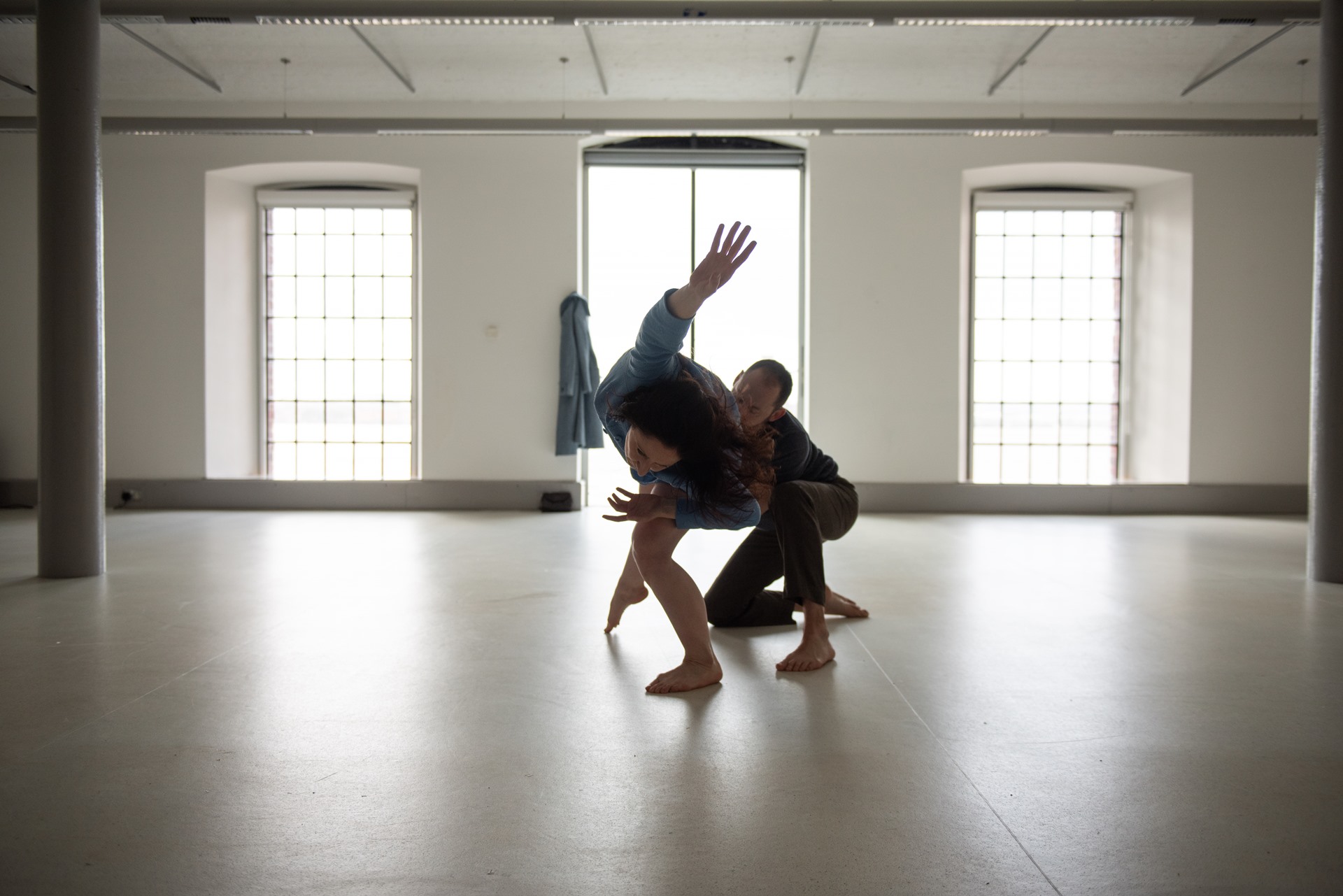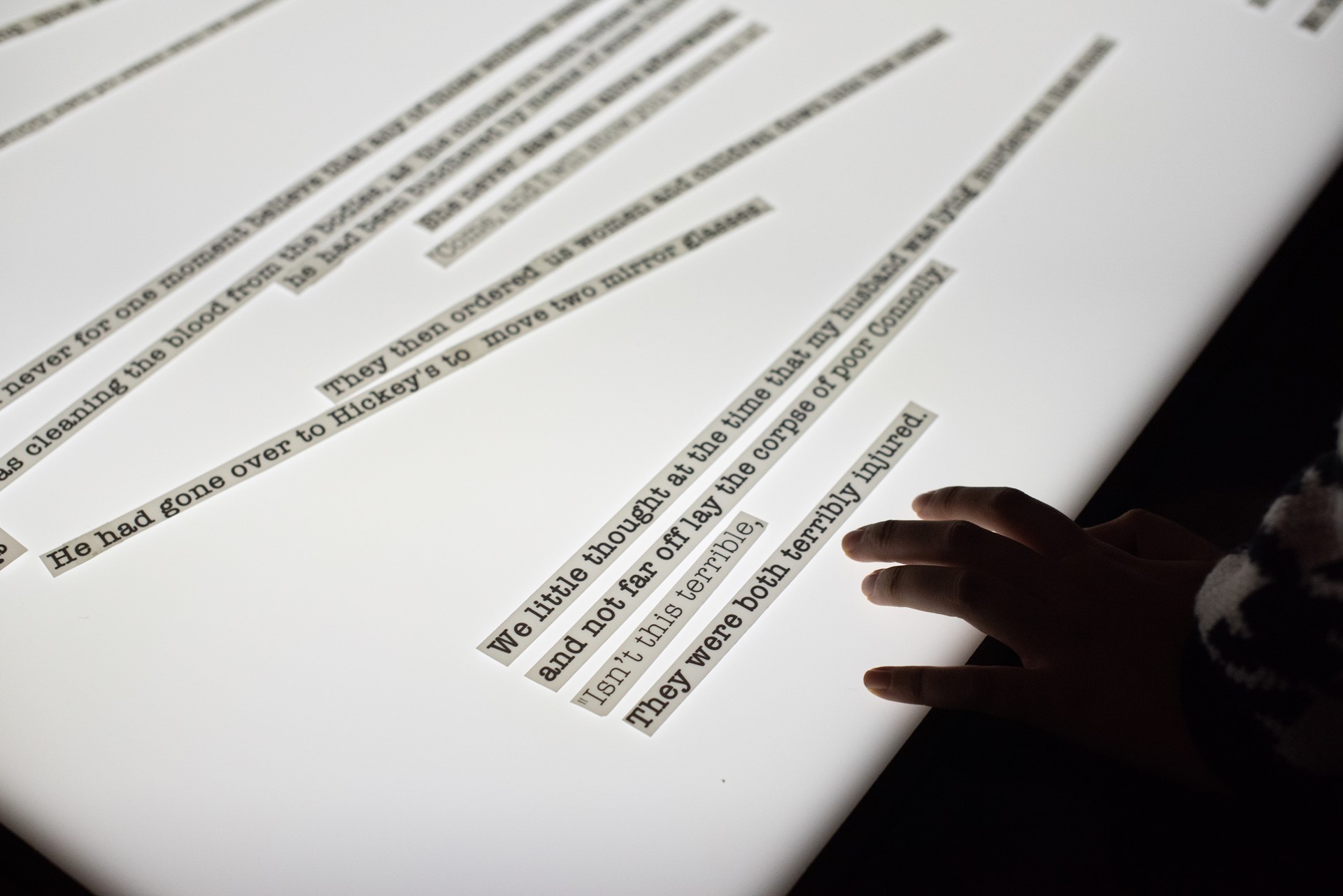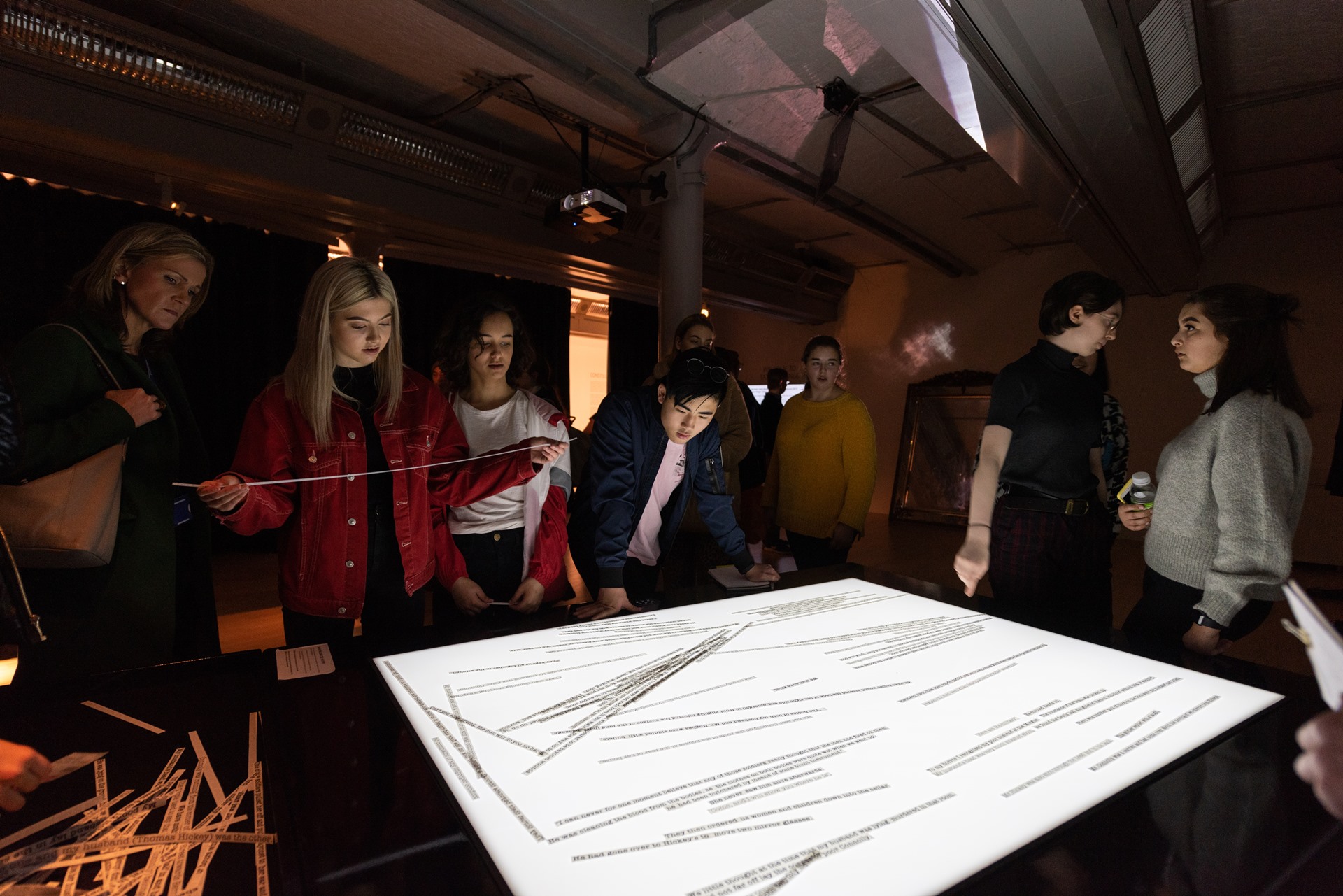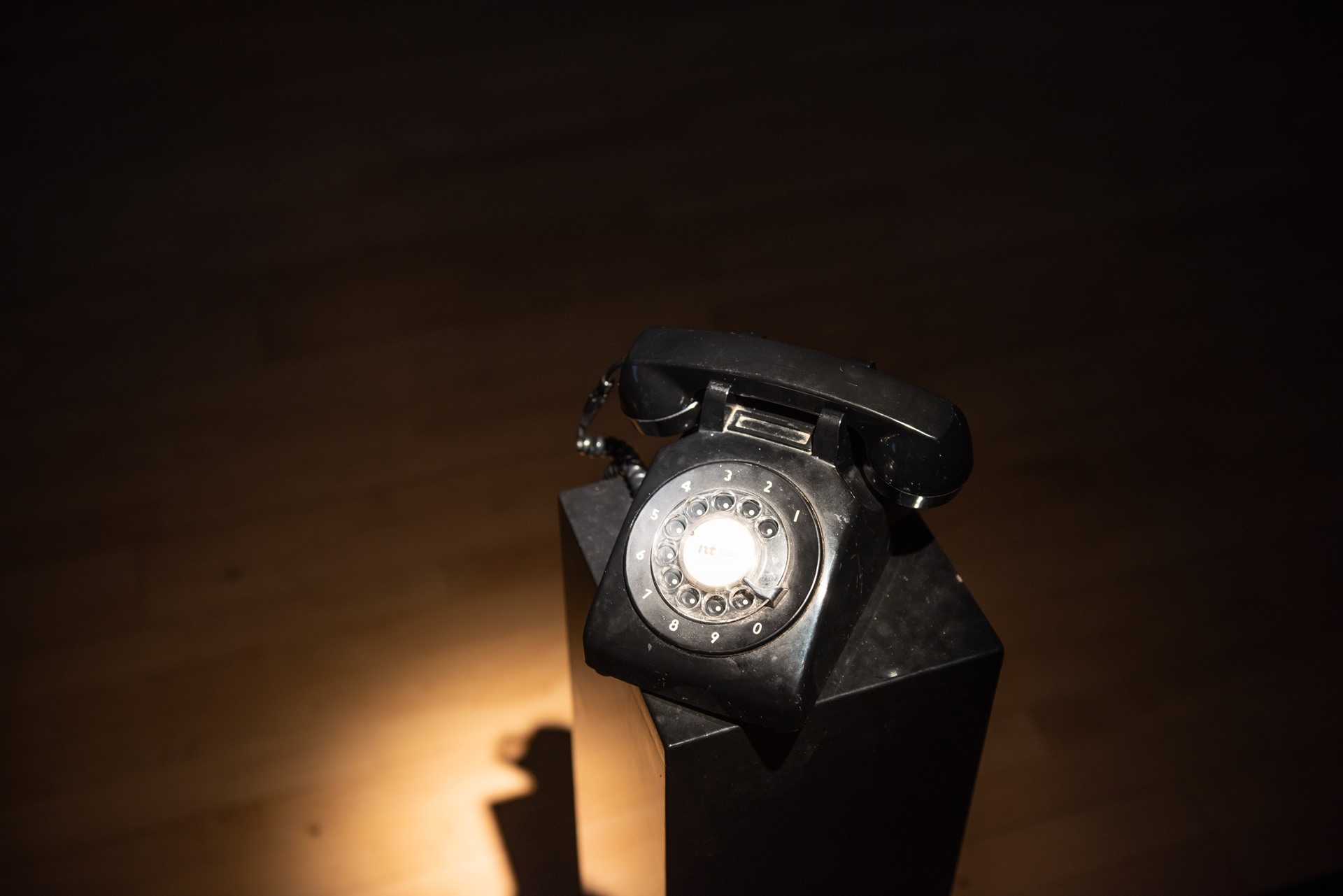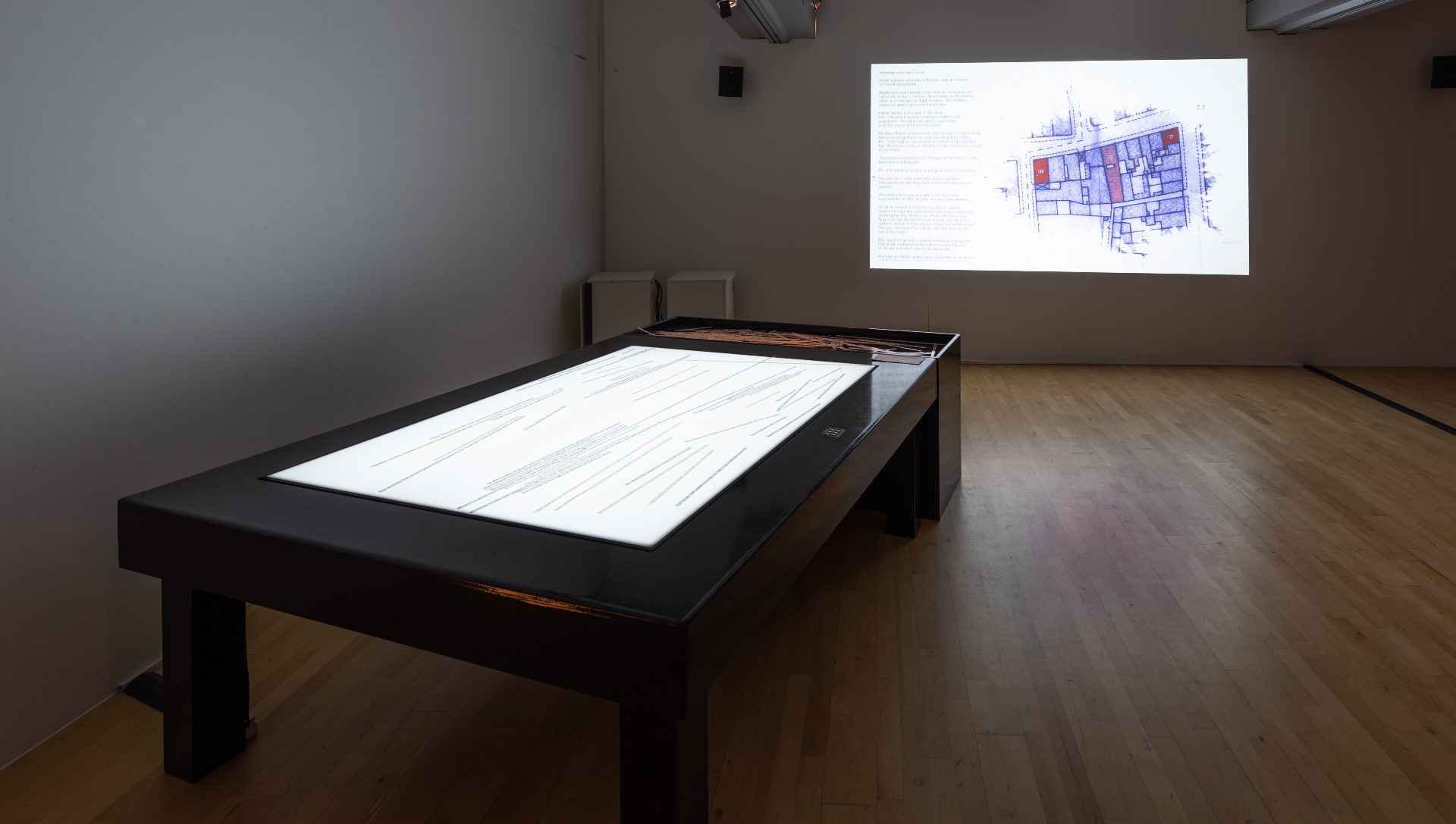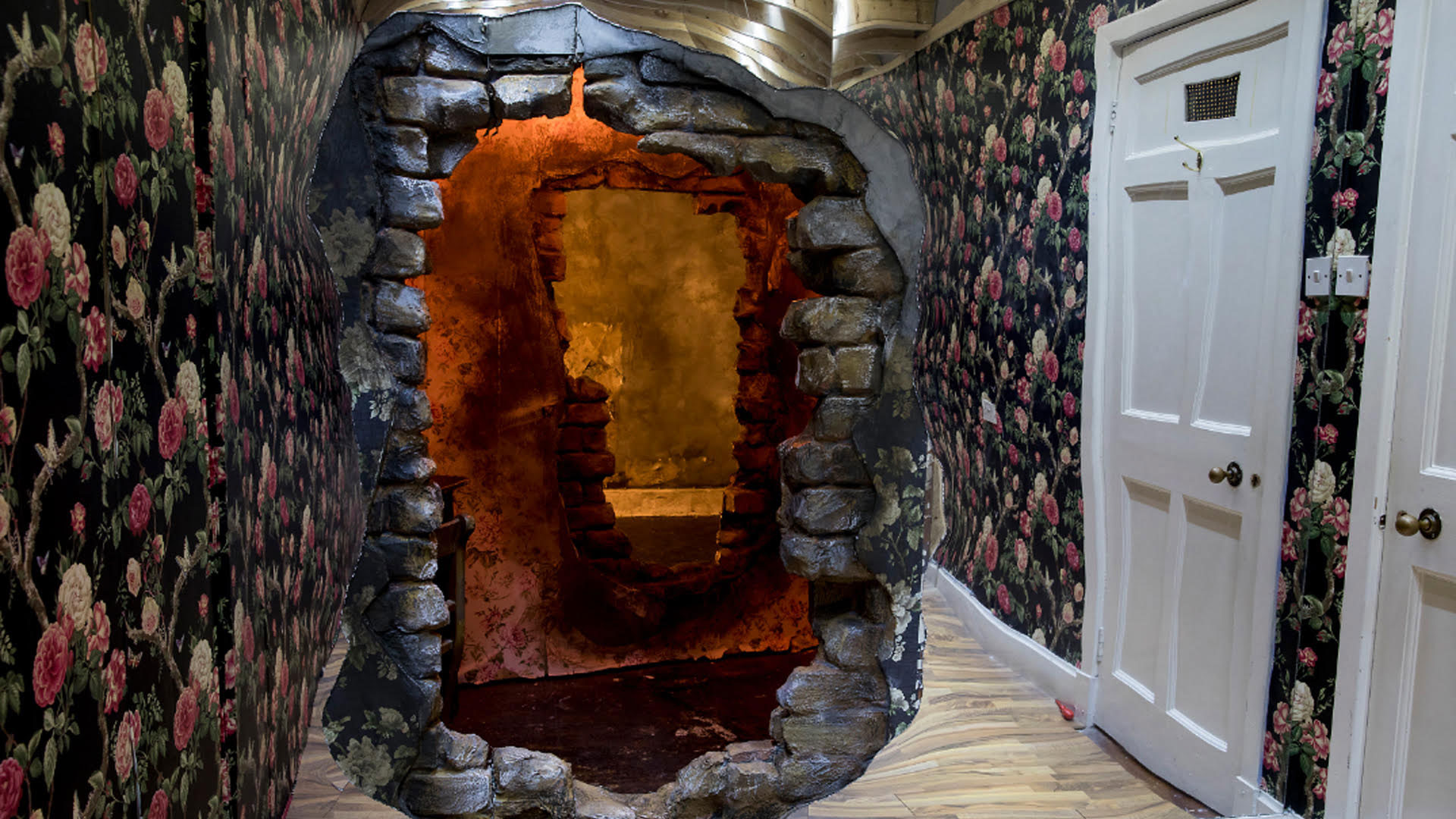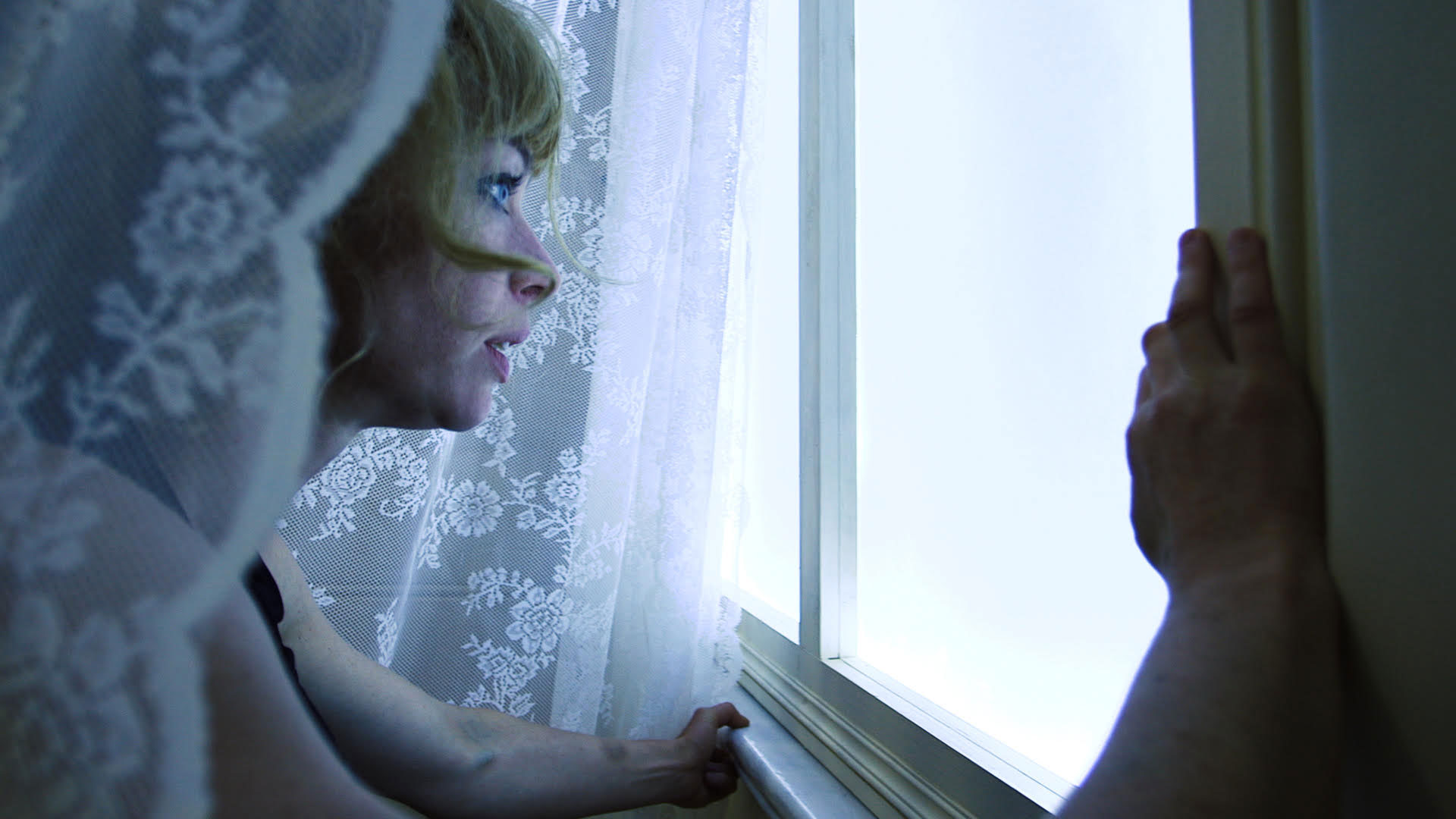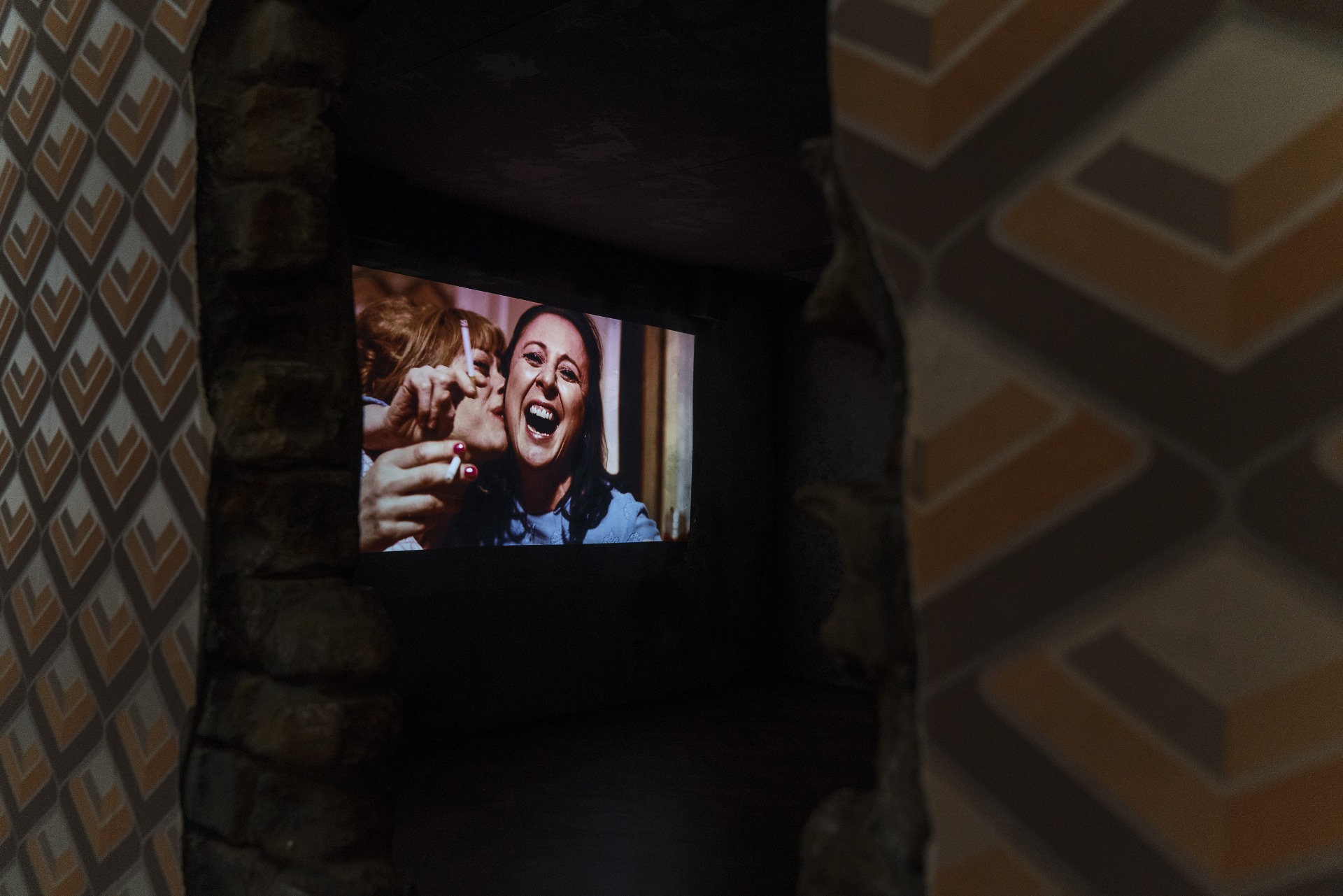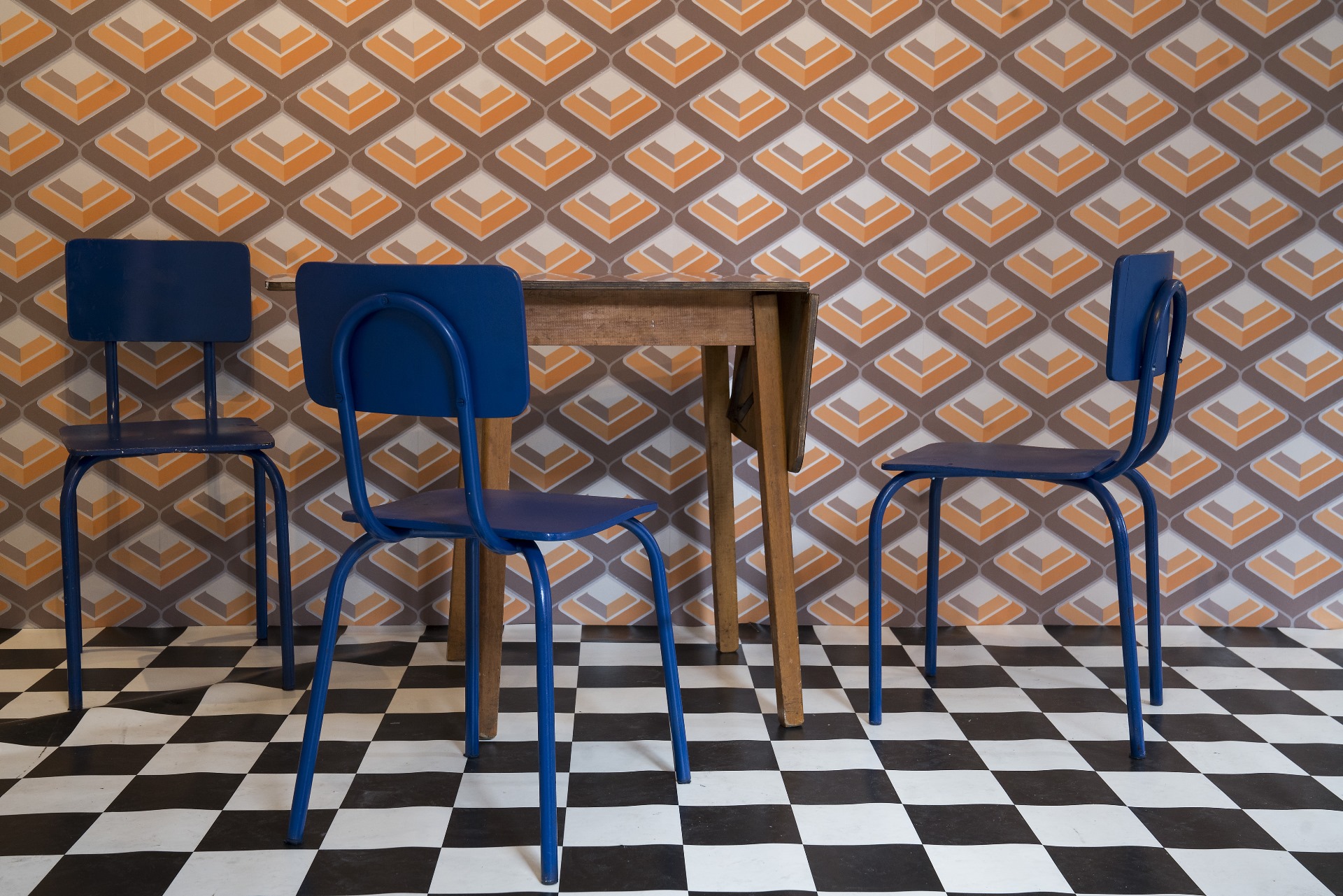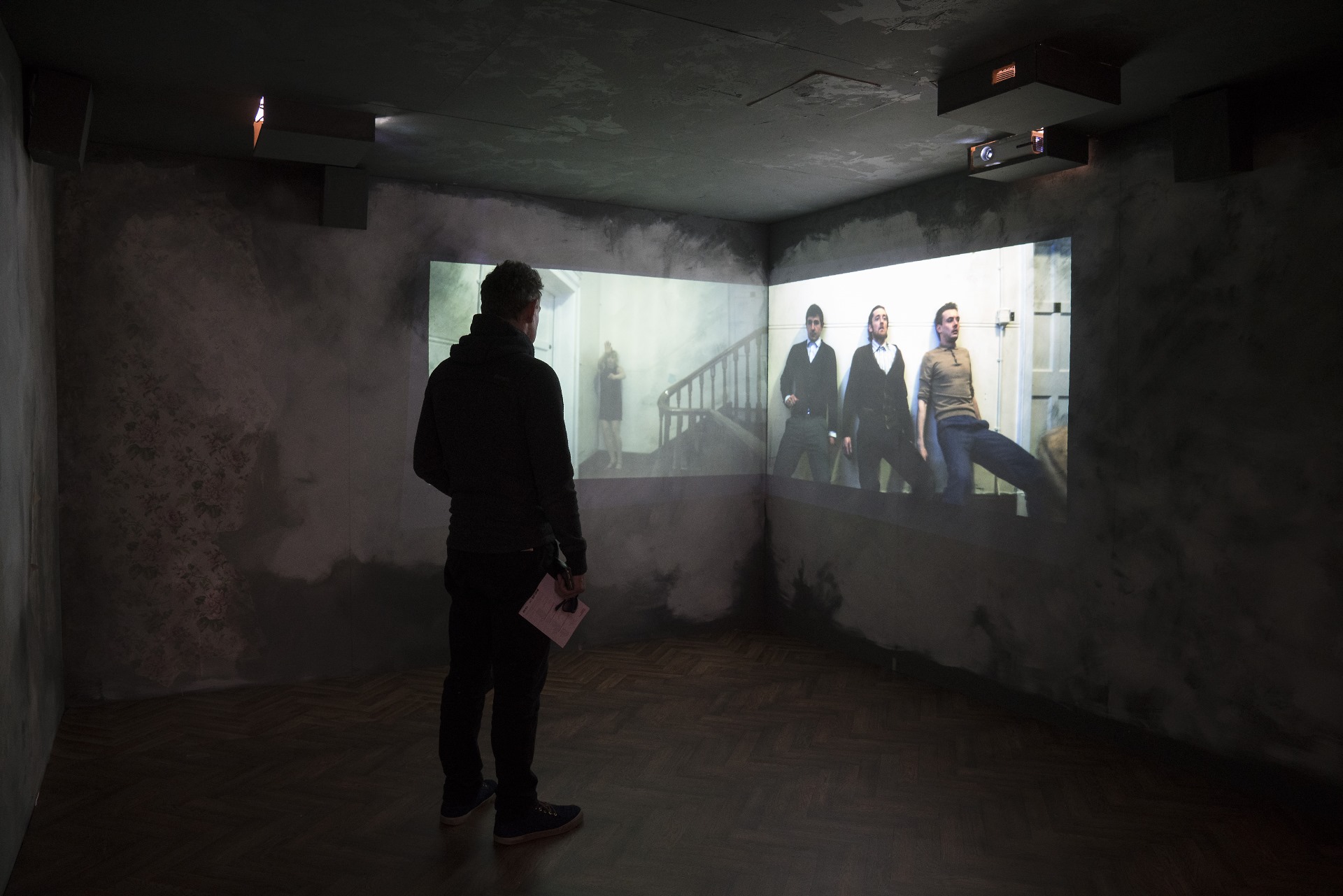BEYOND THESE ROOMS
David Bolger | Owen Boss | Louise Lowe
Bringing complex, conflicted history back to life: one story, two perspectives.
![]() A visual art installation with live performances presented by ANU & CoisCéim Dance Theatre.
A visual art installation with live performances presented by ANU & CoisCéim Dance Theatre.
“My husband, Peter Connolly, was a carrier and a general dealer. He was 39 years of age. On Easter Friday evening at dusk he had gone over to Hickey’s to move two mirror glasses. When the firing began apparently he could not return home, and I never saw him alive again.”
Statement of Mrs Connolly taken from A FRAGMENT OF 1916 HISTORY held at the National Museum of Ireland, Collins Barracks. (reference number 35J 6/13)
“Mrs Hughes told us that she had seen Connolly on the roofs of houses at the rear of her house, leading the rebels across the roofs. I know Connolly to have been a sergeant in the National Volunteers, and Mrs Connolly told me that he gave the Irish volunteers 2 rifles during the Rebellion.”
Statement of Police Sergeant O’Gorman, taken from COURTS OF ENQUIRY INTO THE ALLEGED SHOOTING OF CIVILIANS BY SOLDIERS held at The National Archive, Kew. (reference number WO. 35/67/3)
BEYOND THESE ROOMS is a visual art installation resulting from the live performance work, which continued to interrogate the original archive and research. It propells audiences into the tragic events of Dublin’s North King Street in 1916 through witness testimonies from two key government enquiries, one in Ireland and one in the UK, in a living archive project that encourages people to touch, see, hear, smell and feel the tragedy through a highly focussed lens of the present day.
The installation brings together artefacts, documents, imagery and video to conjoin fact, documentary and fiction, blurring the edges of the real and the imagined in a work where the viewer is actively called upon to bring this complex, conflicted history back to life in an intimate and deeply personal experience.
ADDITIONAL CREDITS | NATIONAL MUSEUM OF IRELAND
Visual Artist: Owen Boss
Collaborating Artists: David Bolger and Louise Lowe
Featuring appearances by
Performer: Justine Cooper
Production Manager: Anthony Hanley
Stage Manager: Caoimhe Coburn Gray
CREDITS | TATE LIVERPOOL
Visual Artist: Owen Boss
Collaborating Artists: David Bolger and Louise Lowe
Symposium Curator: Lynnette Moran
Featuring appearances by
Performers: Jonathan Mitchell, Emma O’Kane and Matthew Williamson
Photography / Film Projection: Hugo Glendinning
Map Animation: Arcade Film
Light Table: Ian Thompson
Costume Design: Niamh Lunny
Music: Denis Clohessy
Sound Recording: Carl Kennedy, Niamh McCann (Voice)
Production Manager: Aaron Kelly
Stage Manager: Dylan Farrell
Transportation: Jason Coogans
Website Assistance: Alexandra Ayvazova
General Manager, CoisCéim: Sarah Latty
Producers: Lynnette Moran, Matthew Smyth, Bridget Webster
BEYOND THESE ROOMS was co-commissioned by 14-18NOW, the UK’s arts programme for the First World War centenary. It resulted from the 2018 production of THESE ROOMS co-commissioned by LIFT and Shoreditch Town Hall, and supported by Culture Ireland as part of the GB18 programme. The Irish Times Irish Theatre award winning 2016 production of THESE ROOMS began as an Open Call National Project in The Arts Council of Ireland’s ART: 2016 programme as part of Ireland 2016.
PREMIERE PRESENTATION | TATE Liverpool as part of TATE Exchange
17 January – 09 February 2019
SPECIAL EVENTS included:
FILM SCREENINGS: 24 / 26 / 27 JANUARY 2019
A Special screening of the FALLING OUT OF STANDING films by David Bolger, Owen Boss and Louise Lowe followed by discussions with the Directors. Click here for details.
LIVE PERFORMANCES: 17/ 18/ 31 JANUARY & 01/ 06/ 07 FEBRUARY 2019
The installation was animated with live performances by Matthew Williamson throughout the day. Click here for details.
BEYOND THESE ROOMS SYMPOSIUM: THURSDAY 07 FEBRUARY 2019
The intersection between art and history
Curated by Lynnette Moran
A one-day discursive event featuring contributions by David Bolger, Owen Boss and Louise Lowe and guest speakers examining the intersection between art and history through a series of keynotes and critical reflections with live performances from Jonathan Mitchell, Emma O’Kane and Mathew Williamson. Key themes included:
- Why remember: what place has history in the modern contemporary art space – object, materials and presentation across art form and culture.
- What art can do for you: who are we making art for and what are the artistic processes, contexts and commissioning propositions that make that happen.
- Where do we go from here: how do we disseminate ephemeral and time-based work with a view to future audiences, readership and legacy.
SYMPOSIUM TICKETS: £10 / £5 concessions -with light lunch.
PRESENTATIONS & PODCASTS
Read Louise Lowe’s presentation here
![]() Panel 2 |What art can do for you: who are we making art for and what are the artistic processes, contexts and positioning propositions that make that happen. Read presentations here by Nigel Hinds, Lynette Moran & Miriam Haughton
Panel 2 |What art can do for you: who are we making art for and what are the artistic processes, contexts and positioning propositions that make that happen. Read presentations here by Nigel Hinds, Lynette Moran & Miriam Haughton
Panel 1 | ![]() Why Remember?
Why Remember?
Listen to discussion here
Panel 3 | ![]() Where Do We Go From Here?
Where Do We Go From Here?
Listen to discussion here
![]() Panel 3 | Where do we go from here? How do we disseminate ephemeral and time-based work with a view to future audiences, readership and legacy. Read Brenda Malone’s presentation here
Panel 3 | Where do we go from here? How do we disseminate ephemeral and time-based work with a view to future audiences, readership and legacy. Read Brenda Malone’s presentation here
Panel 2 | ![]() What Art Can Do For You
What Art Can Do For You
Listen to discussion here
![]() Closing | Discussion, Reflection & Summary
Closing | Discussion, Reflection & Summary
Chaired by Chrissie Tiller
Listen to discussion here
FALLING OUT OF STANDING a film installation
![]() FALLING OUT OF STANDING was borne from the 2016 production of THESE ROOMS. A stand alone structure with three filmic works by David Bolger, Owen Boss and Louise Lowe that inverts traditional concepts of exterior and interior, FALLING OUT OF STANDING aims to extend the debate beyond the interaction of performance and site.
FALLING OUT OF STANDING was borne from the 2016 production of THESE ROOMS. A stand alone structure with three filmic works by David Bolger, Owen Boss and Louise Lowe that inverts traditional concepts of exterior and interior, FALLING OUT OF STANDING aims to extend the debate beyond the interaction of performance and site.
Extending the exploration of source material related to of the North King Street massacre and the subsequent live production of THESE ROOMS, the installation aims to contextualise how the past is propelled into the present and the impact of time on conflicted histories through the form of film.
FALLING OUT OF STANDING
CREDITS
Installation
Visual Artist: Owen Boss
AV Projection: Killian Waters
Sound Design: Carl Kennedy
Production Manager: Adam Fitzsimons
Construction: Ian Thompson
Scenery: Vincent Bell for Bellhouse Scenic Studio
Transport: Oddie Sherwin
Invigilator: Emma Gleeson
Publicist: Conleth Teevan
Film Production Credits
Site Production Manager: Adam Fitzsimons
Site Production Support: Fiona Keller
Site Production Support Assistant: Dylan Farrell
Wardrobe Assistant: Sorcha Ni Fhlionn
Production Support: Clare Creely and Sarah Latty
Producers: Lynnette Moran, Matthew Smyth, Bridget Webster
All films were shot on the art installation created for THESE ROOMS by Owen Boss at 85/86 Dorset Street Upper in October 2016.
WATCH THESE FILMS HERE
Director of Photography: Colum O’Dwyer
Sound Composition: Carl Kennedy
Editor: Colum O’Dwyer
Watch Here
Cast: Craig Connolly, Justine Cooper, Daniel Monaghan, Robbie O’Connor, Emma O’Kane, Matthew Williamson
Director of Photography: Kilian Waters
Sound Composition: Carl Kennedy
Vocals: Alyth McCormack
Editor: Kilian Waters
Costume Design: Niamh Lunny
Watch Here
Cast: Justine Cooper, Una Kavanagh, Niamh McCann, Emma O’Kane
Written by: Una Kavanagh & Louise Lowe
Director of Photography: Paddy Jordan
Sound Composition: Carl Kennedy
Editor: Genevieve Murphy
Costume Design: Niamh Lunny
Watch Here
PAST SCREENINGS
Screenings included introductions/post-screening discussions with the Directors.
Short Films Programme 1
VENUE | Dance Limerick | John’s Square, Limerick
DATES | Friday, November 3, 2017 at 3:00pm 4:00pm
ALSO | On Saturday, November 4, 2017, David Bolger will take part in Interview: Bodies in Time – Embracing History in Screendance
VENUE | Highlanes Gallery, Drogheda
DATES | 24 April – 12 June
Find out more: https://www.highlanes.ie/
Installation Room by Owen Boss
Created by Owen Boss, the installation room for FALLING OUT OF STANDING echoes the spaces where the films were made and the site of the performance work. Inverting traditional concepts of exterior and interior, the space aims to put a contemporary public at the very centre of a rigorous work exploring the concepts of truth and time in conflicted histories.
FALLING OUT OF STANDING information
![]()
The three resulting films were housed in a self-contained installation space and will sequentially project each work to three different locations of the room. The room was realised in a way to echo the spaces where the films where made, the site of the performance work.
The instillation room aims to extend the debate beyond the interaction of performance and site and how the past is propelled into the present. Connected and yet discrete, each film attempted to reconcile the events from diverse perspectives affording the opportunity to interrogate the “unknown knowns” of our national narrative and together in doing so, reaffirm the role of art in negotiating history.
As with the live work, FALLING OUT OF STANDING takes the North King Street massacre as a starting point and aims to contextualise the impact of time on conflicted histories. As we move further away through time this event faded completely from the national consciousness. Its complexities at odds with the State’s foundation myth. It faced further erasure through the political neglect and official ineptitude of town planning of the 1960s and 70s resulting in the row of ten houses being left to decay over decades turning to wasteland and eventually being regenerated as an urban public green space. Historical narrative and physical site become almost invisible.
The opening images of Boss’s film focus on the original site of the massacre on North King Street where today instead of buildings is regenerated as a green space where these films were made. The film then moves to the host building on Dorset Street that housed the live performance and as the camera travels through the installations contained within the building it intersects the residues of the live performance of 2016 calling into question the ability to ever represent the truth of a real event.
Bolger’s film considers how spaces retain memory and begins with the moment that the uninvited rebellion entered the homes of innocent civilians on North King Street. Using two cameras to represent different viewpoints of the same scene, the viewer is invited to witness actions of isolated trauma on a stairwell leading to and from the rooms where the atrocity took place. The speed and force of the invasion is captured by the fast travelling sequences of the camera in both directions as men and women are separated and we witness the immediate aftermath of both the physical and psychological impact.
Presented in a split screen format, this film is a non-linear exploration of how memory and the energy of dramatic events is retained in the walls of buildings themselves and how this anguish is encountered through ghost like sensations in locations of conflict.
Lowe’s film explores the female body as a post-trauma political site. A close up study of grief, isolation and loneliness, it is both tender and violent. Explored in close proximity from an almost carnal vantage point, four women, who have undergone the same ordeal, are thrown together by circumstance, binding them physically and psychologically.
Their physical bodies betray them.
Set in the aftermath of a failed military line up (where they where they were unable to pick out their husband’s killers), the women retreat to a kitchen for respite and comfort. The four women are within and watching at the same time, confronting themselves and ultimately each other.
